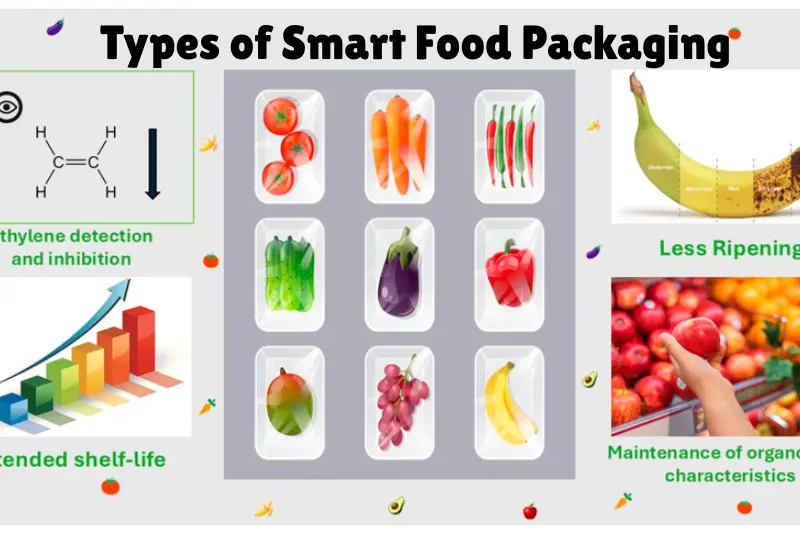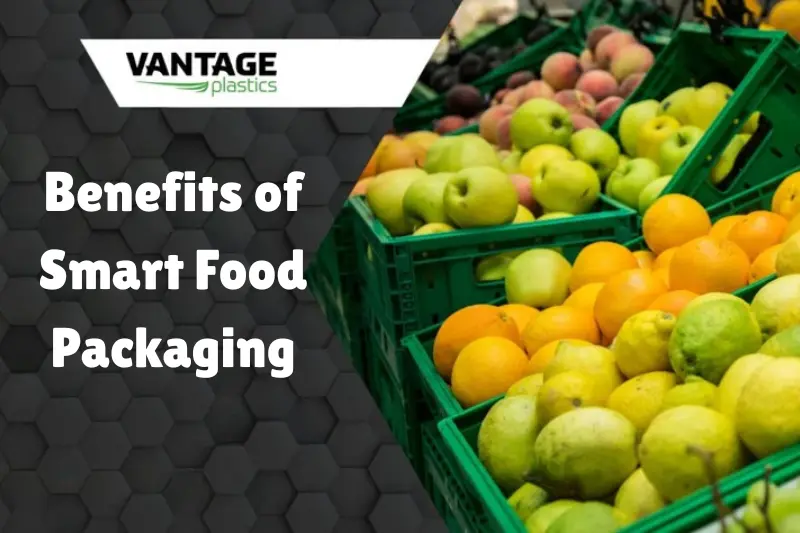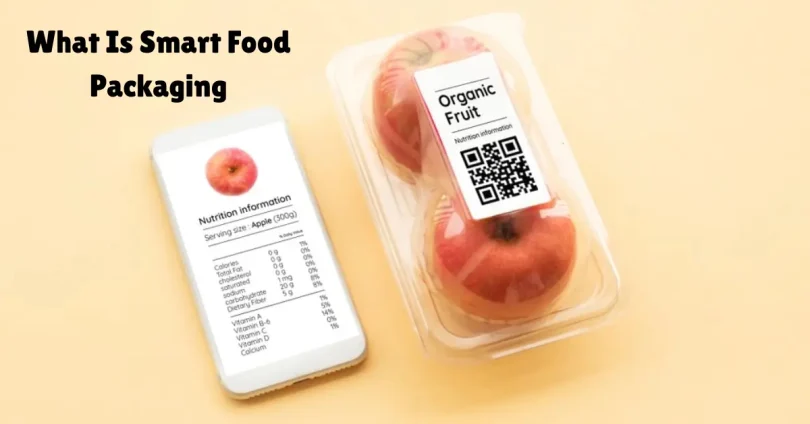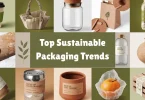In today’s fast-evolving food industry, packaging is no longer just about protecting products during transport or storage. The question “what is smart food packaging” is becoming increasingly important for both consumers and manufacturers who seek improved safety, freshness, and sustainability.
Smart food packaging refers to packaging systems that do far more than simply contain food—they actively monitor the condition of the food, preserve its quality, and communicate vital information to consumers or supply chain stakeholders. By integrating advanced materials, sensors, and digital technologies, smart packaging ensures that food remains safe, fresh, and appealing throughout its shelf life.
Types of Smart Food Packaging

Smart food packaging is not a single technology but a collection of innovative approaches designed to enhance food storage and monitoring. It can be broadly classified into three main types:
1. Active Packaging
Active packaging is designed to interact with the food or its surrounding environment to extend shelf life and maintain quality. It includes:
- Moisture absorbers: Prevent excess moisture that can lead to mold or spoilage.
- Oxygen scavengers: Remove oxygen that causes oxidation and spoilage.
- Antimicrobial coatings: Inhibit bacterial or fungal growth, especially on perishable foods like meat, dairy, and seafood.
By actively preserving food, active packaging reduces waste, protects flavor, and maintains nutritional value.
2. Intelligent Packaging
Intelligent packaging is designed to monitor the condition of the food and communicate relevant information to the consumer or retailer. This type often includes:
- Freshness indicators: Color-changing labels that show whether the food is still safe to consume.
- Time–temperature indicators (TTIs): Track whether the food has been exposed to improper storage conditions.
- QR codes or NFC tags: Provide detailed product information, traceability, and sometimes even recipes or nutritional guidance via smartphone.
Intelligent packaging ensures that consumers have real-time information about food quality, helping them make safer and smarter choices.
3. Edible and Biodegradable Packaging
Some smart packaging solutions focus on environmental sustainability and added functionality. These include:
- Edible packaging: Made from natural materials like seaweed, starch, or proteins, which can sometimes include functional ingredients such as probiotics or antioxidants.
- Biodegradable packaging: Reduces environmental impact while sometimes offering additional smart features like antimicrobial properties.
This type of packaging aligns with global trends toward reducing plastic use and promoting eco-friendly food solutions.
You may also like to read this:
How Plant-Based Foods Are Changing Diets – Complete Guide
Types of Food Trends In 2026: What’s Hot on Your Plate
Why Clean Eating Is More Than A Trend | Complete Guide
Top Best Trending Snacks In The Market For Snack Lovers
Top Future Food Innovations To Watch For Smarter Eating
Key Technologies Behind Smart Food Packaging
Smart food packaging integrates a wide array of advanced technologies to monitor, protect, and extend the life of food products:
- Sensors: Detect spoilage, microbial contamination, or changes in temperature, humidity, or pH. They can alert both retailers and consumers about food safety risks.
- Indicators: Visual cues, such as color-changing labels, indicate freshness, spoilage, or exposure to harmful conditions.
- RFID and NFC Tags: Track food products through the supply chain, ensuring traceability and transparency. Consumers can access detailed product information via smartphones.
- Nanotechnology: Improves barrier properties, enhances antimicrobial activity, and allows precise monitoring of freshness.
- Smart Films and Coatings: Can release preservatives, antioxidants, or antimicrobial agents in response to environmental changes, actively protecting food from spoilage.
These technologies make food storage more reliable and reduce the risk of foodborne illnesses.
Benefits of Smart Food Packaging

Smart food packaging provides numerous advantages for consumers, retailers, and manufacturers:
- Enhanced Food Safety – Detects spoilage, contamination, or improper storage conditions, preventing foodborne illnesses.
- Reduced Food Waste – Freshness indicators and monitoring systems help consumers use food before it goes bad.
- Extended Shelf Life – Active packaging solutions like oxygen scavengers and antimicrobial coatings maintain freshness longer.
- Consumer Convenience – QR codes, indicators, and smartphone integration provide storage tips, nutritional info, and usage guidance.
- Sustainability – Biodegradable or recyclable materials reduce environmental impact while encouraging responsible consumption.
Applications of Smart Food Packaging
Smart food packaging is transforming multiple sectors in the food industry:
- Dairy Products: Milk, cheese, and yogurt can include freshness indicators or oxygen-absorbing packaging to prevent spoilage.
- Meat and Seafood: Packaging with antimicrobial coatings and oxygen scavengers improves safety and extends shelf life.
- Fresh Produce: Sensors and smart films monitor ripeness, humidity, and temperature, ensuring fruits and vegetables remain fresh.
- Packaged Snacks and Beverages: RFID or NFC tags offer traceability, product authenticity, and interactive consumer engagement.
- Frozen Foods: Time–temperature indicators can signal whether the product has been exposed to unsafe storage conditions during transport.
Challenges and Future Trends
While smart food packaging offers numerous benefits, it also faces certain challenges:
- Cost: Advanced sensors, nanomaterials, and RFID tags can increase production costs, limiting adoption for low-cost products.
- Technical Complexity: Integrating electronics and sensors into food-safe packaging requires sophisticated manufacturing and quality control.
- Consumer Acceptance: Some consumers may be hesitant to trust or pay extra for smart packaging technologies.
- Regulatory Compliance: Ensuring that all smart packaging materials and technologies are safe for food contact is critical.
Future trends include:
- Greater integration with IoT and AI, enabling predictive monitoring of food freshness.
- Fully biodegradable smart packaging, reducing environmental impact.
- Interactive packaging that communicates directly with smart appliances, apps, or supply chain systems.
- Widespread adoption in retail, e-commerce, and home delivery, ensuring better food quality from farm to table.
Emerging Innovations in Smart Food Packaging
The field of smart food packaging is constantly evolving. Emerging innovations are pushing the boundaries of what packaging can do:
1. Edible Sensors
Researchers are developing edible sensors that can be safely consumed along with the food. These sensors can monitor freshness, nutrient content, and contamination levels. For example, a sensor embedded in a fruit’s coating might change color if the fruit begins to spoil, offering an immediate visual cue.
2. Blockchain Integration
Blockchain technology is being integrated with smart packaging to ensure complete traceability throughout the food supply chain. Consumers can scan a QR code and instantly verify the origin, handling conditions, and journey of their food from farm to table. This enhances trust and transparency in the food industry.
3. Temperature-Responsive Materials
Some smart packaging materials change their physical properties based on temperature fluctuations. These thermo-responsive materials can indicate if frozen or refrigerated products have been exposed to unsafe temperatures, helping reduce spoilage and foodborne illnesses.
4. Active Antimicrobial Packaging
Advanced packaging is now being developed with embedded antimicrobial nanoparticles that release antimicrobial agents in response to environmental triggers, such as high humidity or microbial growth. This active protection helps extend shelf life and maintain food safety without the need for chemical preservatives.
Environmental Impact and Sustainability
Smart food packaging is not only about safety and convenience—it also has a significant environmental role. Traditional plastic packaging is a major contributor to pollution, but smart packaging solutions are increasingly:
- Biodegradable: Packaging materials that decompose naturally, reducing landfill waste.
- Compostable: Materials that enrich soil when discarded responsibly.
- Reusable: Containers designed for multiple uses, integrated with smart monitoring technologies to track freshness.
By combining eco-friendly materials with smart monitoring, the industry is moving toward sustainable food systems that minimize environmental impact while maximizing food safety.
Impact on the Food Industry
Smart food packaging is transforming the food industry in multiple ways:
- Retailers: Can reduce inventory losses and manage stock more efficiently by knowing exactly when products are at risk of spoilage.
- Consumers: Gain confidence in the safety and quality of the food they purchase, reducing unnecessary waste at home.
- Manufacturers: Can differentiate their products in the market by offering smarter, safer, and more sustainable packaging solutions.
This technological advancement is also enabling personalized food experiences, where packaging can communicate customized information such as recipes, dietary recommendations, or allergen alerts tailored to individual consumers.
Global Market Trends
The smart food packaging market is expected to grow rapidly over the next decade. Key drivers include:
- Rising consumer demand for food safety and quality assurance.
- Increasing awareness of food waste reduction and sustainability.
- Advances in IoT, nanotechnology, and material science.
- Growth of e-commerce and home delivery services, which require smarter packaging to maintain food quality during transport.
Regions such as North America and Europe are leading in adoption, but emerging markets in Asia-Pacific are catching up due to increasing awareness and demand for safe, sustainable food solutions.
Conclusion
Understanding “what is smart food packaging” is crucial as the food industry evolves. Smart packaging not only protects and preserves food but also communicates critical information, enhances safety, and reduces waste. With innovations in sensors, nanotechnology, AI integration, and biodegradable materials, smart food packaging is set to redefine the global food supply chain.
As technology becomes more accessible and cost-effective, smart packaging will become the norm rather than the exception, ensuring a safer, more sustainable, and highly transparent food ecosystem.
FAQs
1. What is smart food packaging?
Smart food packaging refers to packaging systems that go beyond storing or protecting food. They actively monitor freshness, preserve quality, and provide information to consumers or supply chain stakeholders.
2. What are the types of smart food packaging?
There are three main types:
Active Packaging: Interacts with food or its environment to extend shelf life (e.g., oxygen scavengers, moisture absorbers).
Intelligent Packaging: Monitors food condition and communicates information (e.g., freshness indicators, QR codes, NFC tags).
Edible and Biodegradable Packaging: Eco-friendly solutions that can sometimes include functional ingredients like probiotics or antioxidants.
3. How does smart packaging help reduce food waste?
Smart packaging uses indicators and sensors to monitor freshness and spoilage. Consumers and retailers can use this real-time information to consume or sell food before it goes bad, significantly reducing waste.
4. What technologies are used in smart food packaging?
Key technologies include:
Sensors for spoilage, contamination, and environmental changes.
Color-changing indicators to show freshness.
RFID and NFC tags for traceability and product information.
Nanotechnology to improve antimicrobial activity and barrier properties.
Smart films and coatings that release preservatives when needed.
5. What are the benefits of smart food packaging?
Enhanced food safety and quality.
Extended shelf life of perishable products.
Reduced food waste.
Increased consumer convenience with freshness alerts and QR codes.
Sustainable solutions with biodegradable or recyclable materials.





